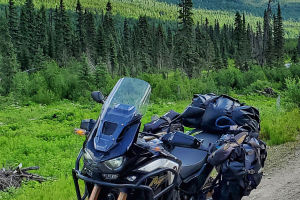A sand bike, also known as a dune bike, is a motorcycle specially designed for driving on desert and sandy terrain.
It features unique designs and components that are tailored for optimal performance in sandy environments and extreme weather conditions.
Let's explore the key features and characteristics associated with sand bikes:
1. Tires: Sand bikes are equipped with wide, low-pressure tires to enhance traction and flotation on desert terrain.
This tire design prevents the bike from getting stuck in the sand and offers superior handling capabilities.
2. Suspension: Sand bikes often boast height-adjustable suspension systems to accommodate various types of desert terrain.
This feature helps absorb shocks and vibrations, ensuring a smoother and more comfortable ride for the rider.
3. Engine Power: Sand motorcycles are typically equipped with larger engines to generate the necessary power and torque for overcoming the resistance of the sand.
This enables them to navigate sand dunes and accelerate quickly.
4. Air Filter: Dune bikes incorporate specialized air filters designed to prevent sand and fine particles from entering the engine.
This is crucial as sand particles can cause damage to the engine if not filtered out effectively.
5. Enhanced Protection: To withstand the challenges of desert environments such as bumps, impacts, and sand erosion, sand bikes are reinforced with sturdy frames and protective panels.
These components safeguard the bike from damage, ensuring increased durability and longevity.
6. Fuel Capacity: Considering the potential for long rides in the desert, sand motorcycles typically feature larger fuel tanks, providing riders with an extended cruising range.
Sand bikes are popular among desert adventurers and enthusiasts who participate in sand bike events.
These motorcycles offer exceptional performance and maneuverability in sandy and desert terrains, allowing riders to conquer obstacles and experience the thrill of the ride.
When it comes to riding a sand bike, safety should always be a top priority. Here are some important considerations to keep in mind:
1. Wearing Safety Gear: It is imperative to wear appropriate safety gear, including helmets, goggles, gloves, long-sleeved shirts, and long pants.
These protective items safeguard the head, eyes, hands, and body, minimizing the risk of injuries.
2. Acquire Proper Training: Before riding a sand bike, ensure that you have received proper training and are familiar with its operation.
Learn how to control the throttle, brakes, and suspension, and how to handle different types of sandy terrain effectively.
3. Select Suitable Locations: Choose designated areas suitable for sand bike riding, such as deserts or sandy regions.
Obtain the necessary permits and adhere to local regulations and laws governing the use of these areas.
4. Inspect and Maintain Your Motorcycle: Prior to each ride, thoroughly inspect all components of your sand bike, including tires, brakes, suspension, lighting, and fuel system.
Maintaining your motorcycle in good working condition and performing regular maintenance tasks are essential for safety and optimal performance.
5. Stay Aware of Sand Conditions: Different types of sand present varying challenges.
Pay close attention to changes in terrain, such as sand dunes, slopes, and desert grasslands.
Observe road conditions and anticipate obstacles, ensuring that you avoid getting stuck or sinking into deep sand.
6. Control Speed and Handling: When riding on sandy terrain, adjust your speed accordingly, particularly in areas with unknown terrain or obstacles.
Practice proper handling techniques such as maintaining balance, steering control, and braking, ensuring a safe and stable ride.
7. Physical Strength and Endurance: Riding a sand bike demands significant physical strength and endurance due to the demanding nature of sandy terrains. Prioritize maintaining good physical fitness and ensure you get sufficient rest to prevent fatigue-induced errors while riding.
8. Respect for the Environment and Others: Display respect for the natural environment and other individuals during sand bike activities.
Comply with local environmental protection regulations, refraining from damaging vegetation or disrupting wildlife habitats.
Moreover, respect the rights and interests of other riders and pedestrians, follow traffic rules, and display courteous behavior.
By adhering to these guidelines, you can enhance the safety and enjoyment of your sand bike riding experience.
Remember to prioritize safety at all times and comply with local laws and regulations.


